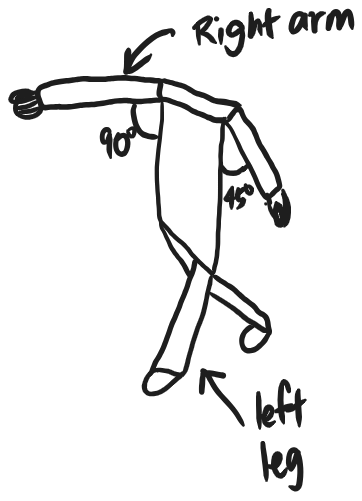Table of contents
Open Table of contents
Introduction
Marching is essential in UGs. NCDCC is no different. You’ll need this for parades, sizing drills, dismissal and falling out drills, amongst other things. Marching itself takes a while to perfect, although it looks easy. In NCDCC, the timing differs. I’ve used left-left-left-right-left, but you may see left-right-left or something similar.
Marching components
Marching can be broken down to 3 things:
- Arms
- Legs
- Timing
- Stopping
There are also 2 types of marching:
- Marching (moving): DARI KIRI/KANAN/TENGAH/DEPAN, CEPAT JALAN (FD Bronze)
- Marching (on the spot): HENTAK KAKI CEPAT, HENTAK (FD Silver, but you would learn it with the command above)
Marching (moving)
Let’s break down the 3 components of marching (moving).
Arms
Your arms are to be locked at the elbow at all times. They alternate with your leg (i.e. left leg, right arm; right leg, left arm). Arms that go up should be raised to a 90° angle. Arms that are not going up should be raised back at a 45° angle. To make it clearer, here’s a diagram:

Yes, it looks like some headless paper man, but I hope you get it. Now, similarly, when you’re on the other arm, it should also be raised to 90°, and your arm behind should be raised back to 45°. Your hand should be the same SEDIA hand position at all times.
Legs
Your legs need to follow the timing. On left, move your left leg forward, and on right, move your right leg forward. You can take normal steps, no need to stomp and march (only some people do that at parades, like the flag-bearers), just take steps that feel natural. No need to shuffle, no need to leap, just walk. Also, make sure that you are walking atthe same pace as those next to you. Maintain the neat row, and don’t be ahead or behind them. This is very important when you BELOK or turn (PUSING) on a march.
Timing
Please, everyone in the contingent is to time at the same time, and loudly (unless specified otherwise by your commander). Try not to time on the wrong leg (when everyone say right, you’re on the left foot), and don’t time wrongly yourself (it’s extremely embarrassing, and is dead obvious: trust me, I know). Additionally, please note that left-left-left-right-left has an unsaid right between the first three lefts. So it would look like left-(right)-left-(right)-left-right-left. Got that?
Stopping
To stop on a march, the command is BERHEN-TI, and the timing is check-one-two. When your commander shouts BERHEN, your contingent is to stop timing. Then, on TI, which will be given on the left foot, you take a step forward on your right leg on check, a step on you left leg on one, and stop and stomp your right foot on two.
Marching (on the spot)
Say you hit a wall. You can’t walk into the wall, so you’ll stop in front of the wall, and march on the spot, following the same timing as marching (moving). Marching on the spot is started when you hit an obstacle when marching (moving), or if you’re given the command HENTAK KAKI CEPAT, HENTAK.
Arms
Your arms are to remain locked. Don’t move them at all. Lock them straight like in SEDIA, at theelbows. Your hand position and shape should be the same - clenched to a fist, thumb tucked out and facing the floor.
Legs
Here comes the tiring part of marching on the spot. When marching on the spot, your legs need to be raised to a 90° angle, so you’re essentially stomping on every step. Now, this becomes very tiring, so you may hear doing HENTAK as a form of threatening/punishment for minutes on end. Deadly.
Timing
See the section on timing for marching (moving).
Stopping
To stop while marching on the spot, the command is also BERHEN-TI, but the timing is check-one. Similarly like marching (moving), your contingent is to stop timing after BERHEN, and once TI is given on the right leg, you stomp on your left foot on check, and stop and stomp on your right foot on one.
What’s the difference if KIRI/KANAN/TENGAH/DEPAN is used?
Good question. The difference is as follows:
- KIRI: Used if you are marching to the commander’s left.
- KANAN: Used if you are marching to the commander’s right.
- TENGAH: Used if the commander is directly in front or behind your contingent.
Conclusion
Marching on the spot or moving is a big topic. Being in sync with the timing, arms and legs take a while to master. Even harder to perfect in doing it in sync as one contingent. Of course, there are ways to do a KE BELAKANG PUSING on a march (TLV, if you’ve heard of that), or left/right wheel with KIRI/KANAN BELOK. I’ll get to that in later posts, but for now, practice marching on the spot and moving. Good luck!